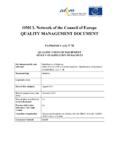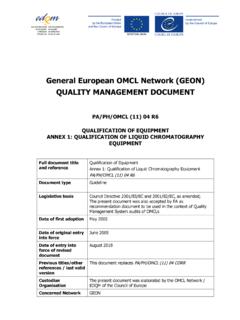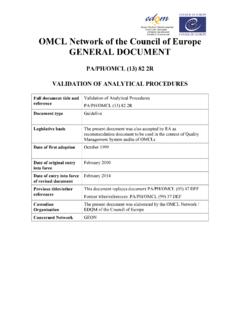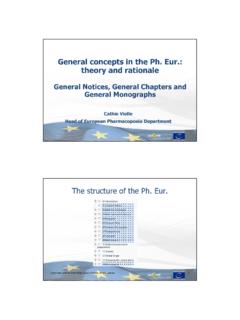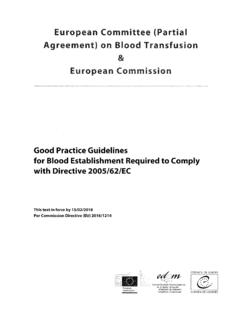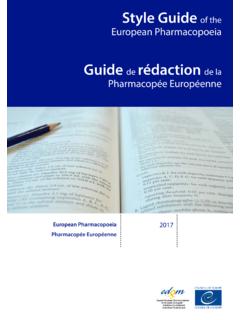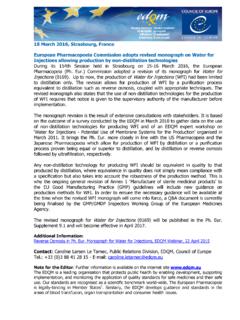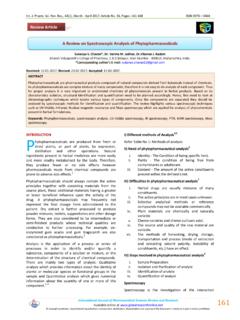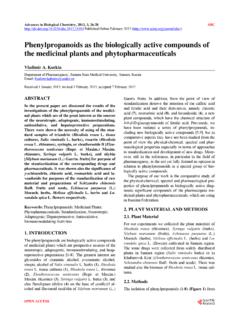Transcription of GGuideuide - EDQM
1 GuideGuide for the elaboration of monographs on herbal drugs and herbal drug preparationsEuropean PharmacopoeiaEuropean Directorate for the Quality of Medicines & HealthCare Edition 2007 Council of Europe, 67075 Strasbourg Cedex, France - 2007 All rights reservedMaking copies of this fi le for commercial purposes or posting this fi le on a website that is open to public consultation is strictly prohibited. 3 CONTENTS herbal DRUGS.
2 5 5 English title .. 5 Latin title .. 5 6 7 Organoleptic 7 Macroscopic and microscopic botanical characters .. 7 7 Macroscopic botanical characters .. 7 Microscopic botanical characters .. 8 Thin-layer 8 TLC prescribed only for the identification of the herbal drug ..8 TLC prescribed under tests and identification ..11 Liquid or gas chromatography .. 12 Chemical reactions for identification .. 12 13 Typical tests .. 13 Total ash ( ) .. 13 Ash insoluble in hydrochloric acid ( ).. 13 Thin-layer chromatography ( ) .. 13 Gas chromatography ( ) or liquid chromatography ( ).
3 13 Foreign matter ( ).. 14 Heavy metals ..14 Loss on drying ( ) .. 14 Water ( ) .. 14 Swelling index ( ) .. 15 Bitterness value ( ) .. 15 Extractable matter .. 15 Other 15 4 16 Ultraviolet and visible absorption spectrophotometry .. 16 Determination of tannins in herbal drugs ( ) ..17 Volumetric titration .. 17 Determination of essential oils in herbal drugs ( ) .. 17 Liquid chromatography ( ) and gas chromatography ( ) .. 17 18 19 CHEMICAL REFERENCE SUBSTANCES (CRSs).
4 19 herbal drug 20 EXTRACTS .. 20 20 21 21 21 21 Ethanol .. 21 Residual solvents in dry 21 Loss on drying ..21 22 22 22 PREPARED 22 22 22 22 herbal 22 5 A monograph on a herbal drug or a herbal drug preparation is drafted with the same overall 1 structure as a monograph on a chemical substance and both the latest versions of the 2 Technical guide for the elaboration of monographs and of the Style guide apply to 3 monographs on herbal drugs
5 And herbal drug preparations. This Guide develops the specific 4 points that are relevant to herbal drugs and herbal drug preparations and that are not presented 5 in the above-mentioned general Guides. 6 It is recalled that all tests and assay methods described in a monograph must be validated 7 according to the procedures stated in the Technical guide. 8 The general monograph herbal drugs (1433) applies to all herbal drugs for medicinal use and 9 its provisions must be taken into account when elaborating specific monographs. The general 10 monograph herbal drug preparations (1434) applies to all herbal drug preparations for 11 medicinal use and its provisions must be taken into account when elaborating specific 12 monographs.
6 13 herbal DRUGS 14 NOMENCLATURE 15 ENGLISH TITLE 16 Many herbal drugs have a well-established name in English and this is usually used as the 17 title. 18 Example: Cascara 19 The plant part used may be included in the title, particularly where different herbal drugs are 20 derived from the same plant. 21 Example: Hawthorn leaf and flower 22 Hawthorn berries 23 Where there is no common name, the title is derived from the scientific name. 24 Example: Psyllium seed 25 LATIN TITLE 26 The Latin title is derived from the scientific name of the source plant.
7 It is formed by the 27 genus (genitive) and/or species (genitive) names, followed by the name of the organ used 28 (nominative and singular). 29 Example: Belladonnae folium 30 A more common name may also be used. 31 Example: Chamomillae romanae flos 32 Where appropriate the state of the drug is indicated in the English and Latin titles. 33 Example: Bilberry fruit, dried 34 Myrtilli fructus siccus 35 Example: Bilberry fruit, fresh 36 Myrtilli fructus recens 37 6 DEFINITION 1 Some or all of the following are usually included in the definition: 2 the state of the drug : whole, fragmented, peeled, cut, fresh or dried.
8 3 the complete scientific name of the plant (genus, species, subspecies, variety, author) as 4 obtained from the Kew Index and its supplements (International Plant Names Index 5 IPNI); commonly used synonyms may be mentioned; 6 the part or parts of the plant used (written in the singular); 7 where appropriate, the stage in the growth cycle when harvesting takes place, or other 8 necessary information; 9 wherever possible, the minimum content of quantified constituents (constituents with 10 known therapeutic activity or markers); herbal drugs very often contain a mixture of 11 related substances, in which case the total content of quantified constituents is 12 determined and expressed as one of the constituents, usually the major constituent; 13 separate limits may be given for different forms of the drug (whole/cut).
9 14 The statements (dried drug ) or (anhydrous drug ) imply that the monograph prescribes 15 respectively a test for loss on drying ( ) or a determination of water by distillation 16 ( ). In practice the dried drug is dried again when the loss on drying test is performed. 17 The title is not repeated in the definition. 18 Example: 19 Dried flowering aerial parts of Viola arvensis Murr. or Viola tricolor L. 20 Content: minimum per cent of total flavonoids, expressed as violanthin 21 (C27H30O14; Mr ) (dried drug ). 22 Example: 23 Dried cremocarp and mericarp of Foeniculum vulgare Mill.
10 Ssp. vulgare var. vulgare. 24 Content: 25 essential oil: minimum 40 ml/kg (anhydrous drug ); 26 anethole: minimum per cent in the essential oil; 27 fenchone: minimum per cent in the essential oil. 28 Example: 29 Whole or cut, dried rhizome and root of Levisticum officinale Koch. 30 Content: 31 for the whole drug : minimum ml/kg of essential oil (dried drug ); 32 for the cut drug : minimum ml/kg of essential oil (dried drug ). 33 7 CHARACTERS 1 This section contains a brief description of the physical characters of the drug .

